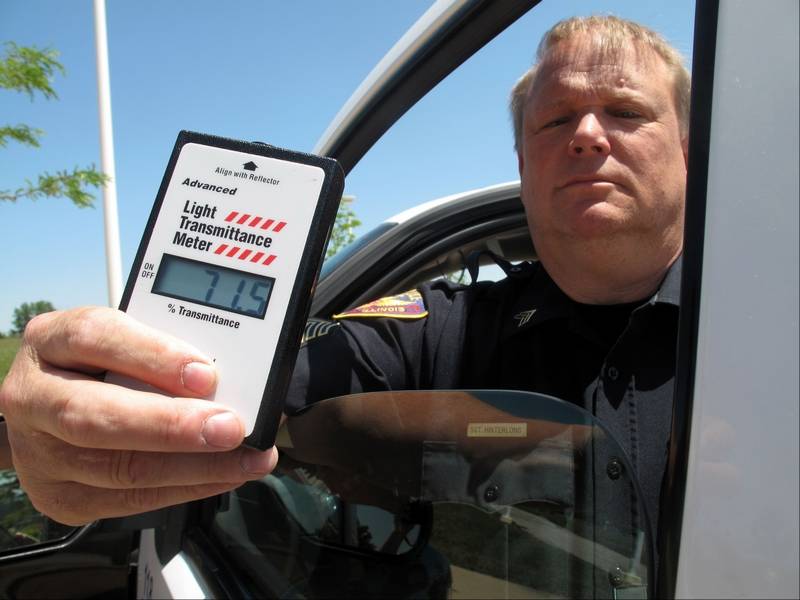California Window Tinting Laws
The state of California has very specific laws regarding window tinting on your car. Every state in the United States has its own percentage of darkness and reflection which your car windows are allowed to have, as well as other specific regulations you may need to know about.
California tint laws allow 70% VLT on front side windows, and any darkness on windows behind driver. Front windshield tint is not allowed.
Below is all relevant information pertaining to tinted windows in California.
Window tint darkness
The amount of light that can pass through your vehicle windows is measured in percentages (called VLT). Your tinting film must conform to these standards. Tint laws in California are the same for all vehicle types, whether sedans or SUVs or vans.
- Windshield allows transparent strip on top 4-5 inches.
- Front side windows must pass through more than 70% of light inside your car (70% VLT).
- Back side windows and rear windshield can have any darkness.
Let’s take a closer look at California tinting laws, as there are other rules and regulations you must be aware of.
Front windshield tint
California tint laws allow tinting front windshield only on top 4 to 5 inches. This is the so-called AS-1 line.
This top windshield strip must be transparent, and no opaque lettering or visibility distortion is allowed.
As regulated by laws, the material’s lower edge should be a minimum of 29 inches above the undepressed driver’s seat. You must measure this from a point five inches in front of the bottom of the backrest, while the driver’s seat is in its rearmost and lowermost position, and the vehicle is on a level surface.
Front side window tinting
Factory-made windows typically already have a small level of tint and will block a small percentage of light coming through windows. This is why California laws are very specific, and only permit using tint film with higher than 88% VLT.

California tint laws allow 70% VLT tint on front side windows, and any tint on windows behind driver.
Because California requires a legible certificate on windows with aftermarket tinting applied, we do not recommend using less than 88% VLT tint on front side windows.
Window tint reflection
California doesn’t allow the usage of tinting film which has more reflection than a standard window.
Some tinting film can reflect incoming light, therefore reducing glare and heat even further. Reflective tint gives windows a metallic, mirror-like appearance, which can blind other drivers.
Side mirrors
If your rear window is tinted, you must have exterior rear view mirrors on each side of the vehicle.
Restricted tint colors
California specifically prohibits using any red or amber colored tint film on front windshield. Other colors are permitted for the windshield top strip (AS-1 line where tinting is allowed). No color-altering tint is permitted on any other windows.
Medical exemptions
Many states allow different window tint percentages due to certain medical conditions. California drivers are able to get medical exceptions for window tint ever since Assembly Bill No. 1303 has been approved back in 2017.
Under current California tint laws, persons with medical conditions requiring shielding from UV rays can install clear, colorless and transparent material on any window. Drivers must obtain a written statement from a licensed physician. This statement certifies that driver or occupants need to be shaded from the sun due to a medical condition.
However, and this is important: California tint law does not permit these devices to be used during darkness (see CA Vehicle Code 26708.2 for reference below). This effectively means darker window tint film even with a medical exemption is illegal.
Law regulates that any sun-screening devices beyond legal limits (i.e. under medical exemptions) must be removable. Additionally, these devices need to have at least 35% VLT and reflection, and must be green, gray or neutral smoke in color.
Window film certificate
Drivers are required to have a certificate signed by the tint installing company, or from the film manufacturer. This certificate or label must display the VLT percentage clearly. Label must also display tint film manufacturer’s name and address. Manufacturers are also required to certify the tinting film in California before they are allowed to sell it.
Penalties and fines
The penalties for illegal window tint in California may include fines and the requirement to remove or modify the tint.
Law enforcement officers may issue a “fix-it” ticket, which means you have a certain period to correct the tint to comply with the law and have the violation signed off by an authorized person (such as a law enforcement officer).
The fine amount for illegal window tint in California can vary depending on the circumstances and the number of offenses. Generally, fines for window tint violations in California can range from around $100 to $250 or more for each offense.
In some cases, your vehicle may be subject to inspection to ensure compliance with window tint laws. This can further increase financial penalties.
Some towns or counties in California may have their own special regulations about window tinting. If you’re in doubt about tint laws be sure to check with your local law enforcement or DMV offices!
